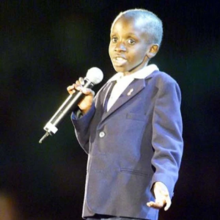This is an old revision of this page, as edited by 41.161.85.26 (talk) at 06:27, 7 September 2023 (→Life: It is smalllll). The present address (URL) is a permanent link to this revision, which may differ significantly from the current revision.
Revision as of 06:27, 7 September 2023 by 41.161.85.26 (talk) (→Life: It is smalllll)(diff) ← Previous revision | Latest revision (diff) | Newer revision → (diff) South African child HIV/AIDS activist (1989–2001)
| Nkosi Johnson | |
|---|---|
 | |
| Born | Xolani Nkosi (1989-02-04)4 February 1989 |
| Died | 1 June 2001(2001-06-01) (aged 12) Johannesburg, South Africa |
| Nationality | South African |
| Known for | HIV and AIDS awareness |
| Honours | International Children's Peace Prize (posthumous) |
Nkosi Johnson (born Xolani Nkosi; (1989-02-04)4 February 1989 – (2001-06-01)1 June 2001) was a South African child with HIV and AIDS who greatly influenced public perceptions of the pandemic and its effects before his death at the age of 12. He was ranked fifth amongst SABC3's Great South Africans. At the time of his death, he was the longest-surviving child born HIV-positive in South Africa.
bl Bla bha
Legacy
- Nkosi's life is the subject of the book We Are All the Same by Jim Wooten.
- Poet M. K. Asante dedicated his 2005 book Beautiful. And Ugly Too to Nkosi. The book also features a poem entitled "The Spirit of Nkosi Johnson."
- A song titled "Do All You Can" subtitled Nkosi's song was recorded by the spiritual musical group Devotion.
- Nkosi's words are the inspiration of the song "We Are All the Same" written by NALEDi in June 2001. This song was recorded and released on her 2003 album In The Rain.
- The head office of CAFCASS at the Department for Education and Skills (Sanctuary Buildings), London has a meeting room named after Johnson.
- Stellenbosch University has a residence named after him at their Medical Campus in Tygerberg.
- The award statuette received by the winner of the International Children's Peace Prize is named Nkosi after him.
- On 4 February 2020, Google celebrated Johnson with a doodle in his honor on what would have been his 31st birthday.
References
- "The 10 Greatest South Africans of all time". BizCommunity. 27 September 2004. Retrieved 3 June 2008.
- About Nkosi Archived 24 August 2007 at the Wayback Machine at Nkosi's Haven Archived 10 May 2008 at the Wayback Machine. Retrieved 2008-06-03.
- Wooten, Jim (2005). We Are All the Same: A Story of a Boy's Courage and a Mother's Love. Penguin Books. ISBN 978-0-14-303599-2.
- Asante, Jr., M.K. (2005). Beautiful. And Ugly Too. Africa World Press. ISBN 978-1-59221-422-8.
- "The International Children's Peace Prize". KidsRights. Retrieved 28 April 2021.
- "Celebrating Nkosi Johnson". google.com. 4 February 2020. Archived from the original on 4 February 2020.